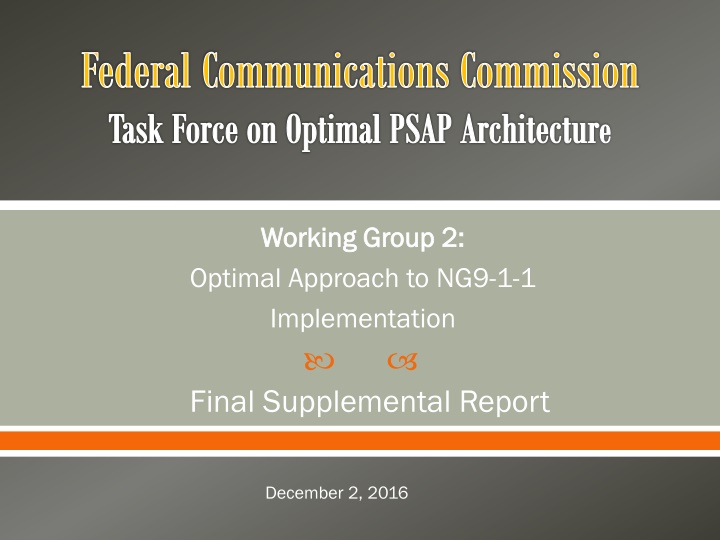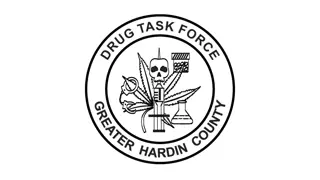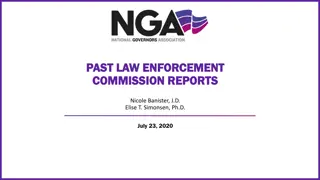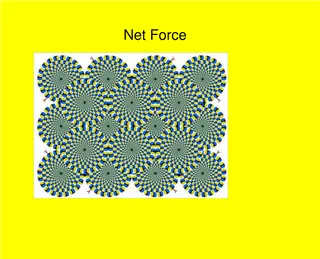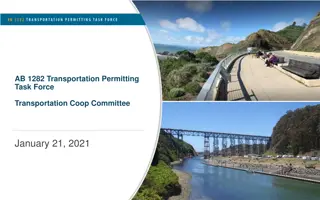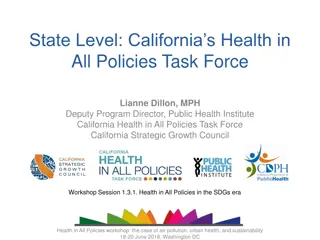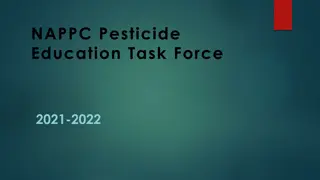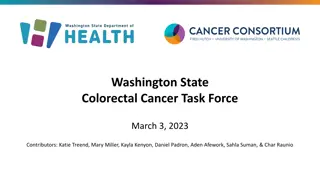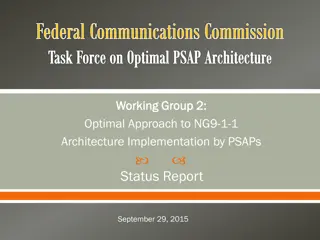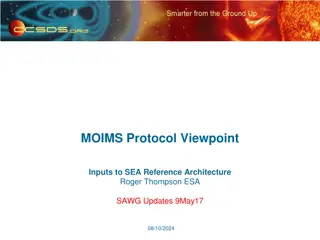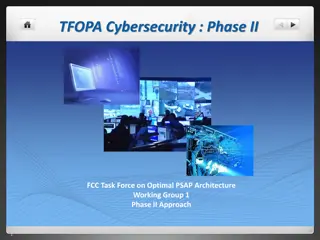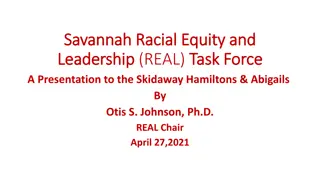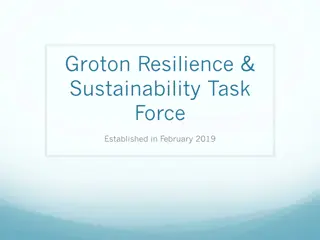Federal Communications Commission Task Force on Optimal PSAP Architecture
This document provides insights into the working group leadership and members of the Federal Communications Commission Task Force on Optimal PSAP Architecture. It highlights their roles, affiliations, and contributions to the NG9-1-1 implementation. The TFOPA aims to enhance security, operations, and funding for Public Safety Answering Points during the migration to Next Generation 9-1-1.
Download Presentation

Please find below an Image/Link to download the presentation.
The content on the website is provided AS IS for your information and personal use only. It may not be sold, licensed, or shared on other websites without obtaining consent from the author.If you encounter any issues during the download, it is possible that the publisher has removed the file from their server.
You are allowed to download the files provided on this website for personal or commercial use, subject to the condition that they are used lawfully. All files are the property of their respective owners.
The content on the website is provided AS IS for your information and personal use only. It may not be sold, licensed, or shared on other websites without obtaining consent from the author.
E N D
Presentation Transcript
Federal Communications Commission Task Force on Optimal PSAP Architecture Working Group 2: Working Group 2: Optimal Approach to NG9-1-1 Implementation Final Supplemental Report December 2, 2016
Working Group 2 Leadership Working Group 2 Leadership Working Group 2 Leadership Director of 9-1-1 / Public Safety Comm. Steve Souder Steve Souder Fairfax County VA TFOPA Chairman Dana Wahlberg Dana Wahlberg State of Minnesota 9-1-1 Program Manager TFOPA Vice Chair David Holl David Holl Lower Allen Twp., PA Director of Public Safety WG2 Chairman Roger Hixson Roger Hixson NENA Technical Issues Director WG2A Co-Chair Bill Mertka Bill Mertka Motorola Sr. Product Planning Consultant WG2A Co-Chair Jeff Wittek Jeff Wittek Airbus DS Communications Chief Strategic Officer WG2B Co-Chair WG2B Co-Chair WG2C Co-Chair Mary Boyd Mary Boyd West Safety Services VP External Affairs April Heinze April Heinze INdigital Industry Affairs Specialist WG2C Co-Chair Alicia Burns Alicia Burns The Digital Decision NG9-1-1 Consultant WG2D Co-Chair TFOPA WG2 NG9-1-1 Optimal NG9-1-1 Service Architecture 2
Working Group 2 Members Working Group 2 Members Working Group 2 Members Bernard Aboba Bernard Aboba Microsoft - Skype Principal Architect WG2A Bradley Blanken Bradley Blanken Competitive Carrier Association VP Industry Development WG2C Ron Bloom Ron Bloom Frontier Communications 9-1-1 Services Manager WG2D Alfredo Bocanegra Alfredo Bocanegra 9-1-1ResQ CEO WG2B, WG2C Daryl Branson Daryl Branson Colorado Public Utilities Commission Sr. 9-1-1 Telecom Analyst WG2D Bob Brown Bob Brown NPSTC IT Manager, NH 9-1-1 WG2A, WG2B Laurie Flaherty Laurie Flaherty NHTSA Coordinator, National 9-1-1 Program Office WG2B Mark Fletcher Mark Fletcher Avaya Chief Architect WG2A, WG2B, WG2C Jim Goerke Jim Goerke Texas 9-1-1 Alliance CEO WG2A, WG2B Joe Heaps Joe Heaps NIJ / DOJ Program Manager WG2B Mike Nelson Mike Nelson West Safety Services VP Sr. Technical Officer WG2A, WG2B Dusty Rhoads Dusty Rhoads DHS/OEC Branch Chief WG2A, WG2B Chuck Spalding Chuck Spalding Palm Beach County, FL Director NG9-1-1 Technical Services WG2D Chuck Vick Chuck Vick Verizon E9-1-1 Group Manager WG2A Patti West Patti West BRETSA, CO Sr. Consultant for AltaVista Group WG2C North Central Texas Council of Governments Christy Williams Christy Williams Director of 9-1-1 WG2D TFOPA WG2 NG9-1-1 Optimal PSAP Architecture 3
Introduction The Task Force on Optimal PSAP Architecture (TFOPA) is a federal advisory committee chartered under the Federal Advisory Committee Act (FACA) to provide recommendations to the Federal Communications Commission (FCC) regarding actions Public Safety Answering Points (PSAPs) and 9-1-1 Authorities might take to enhance security, operations, and funding as Next Generation 9-1-1 migration occurs On January 29, 2016 TFOPA released an Adopted Final Report completing the work of Phase I TFOPA WG2 NG9-1-1 Optimal PSAP Architecture 4
Introduction -cont.. In Phase II of TFOPA, Working Group 2 was charged with four tasks: o 1) Developing a NG9-1-1 Readiness Scorecard o 2) Developing a Framework for NG9-1-1 Planning o 3) Workforce Staffing and Training for NG9-1-1 o 4) ESInet: Lessons Learned from Early Adopters WG2 s discussion led to broadening the scope of this activity, recognizing the critical/essential role of the PSAP while simultaneously acknowledging the 9-1-1 Authority and PSAP role in the end-state of a NG9 NG9- -1 1- -1 Ecosystem 1 Ecosystem TFOPA WG2 NG9-1-1 Optimal PSAP Architecture 5
NG9-1-1 Components The below diagram, as presented in the TFOPA Phase I Final Report, illustrates the role of the PSAP in a fully deployed NG9-1-1 end state. TFOPA WG2 NG9-1-1 Optimal PSAP Architecture 6
A New Paradigm for 9-1-1 As plans for and implementation of NG9-1-1 systems continue, the 9-1-1 community has an opportunity to embrace the new NG9-1-1 Paradigm to enhance existing and build new cooperative relationships/partnerships. The 9-1-1 community will continue to make progress in transitioning the 9-1-1 system from legacy to full end state deployment of NG9-1-1 as described in both the TFOPA January Report and the WG2 Supplemental. In WG2 s Phase II discussions, a more evolved conceptual model developed of the transitional steps to the implementation of NG9-1-1. TFOPA WG2 NG9-1-1 Optimal PSAP Architecture 7
Current State of NG9-1-1 Development Today, many 9-1-1 Systems and Agencies remain in the Legacy State. The slow transition has been impacted by many factors, including but not limited to: o the absence of agency buy-in resulting from a lack of understanding of the elements associated with a transition to the NG9-1-1 end state o inadequate funding o incomplete or incoherent accredited standards o lack of stakeholder outreach o potential job losses o day-to-day demands which do not afford the time to plan for such a significant change TFOPA WG2 NG9-1-1 Optimal PSAP Architecture 8
Required Considerations The below diagram illustrates the NG9-1-1 Roles and Relationships for deployment of NG9-1-1 services. TFOPA WG2 NG9-1-1 Optimal PSAP Architecture 9
The Path Forward to NG9-1-1 TFOPA WG2 hopes that PSAP managers, 9-1-1 Authority managers, elected officials at the local, state, tribal and federal levels come to an understanding to create NG9-1-1 end states regionally, at the state level and the national level. All efforts should be made to compress the timeline of this development and implementation so as to manage it in a planned evolution as opposed to a crisis managed reactionary implementation as TDM is replaced by IP technology. With this in mind, WG2 developed the NG9-1-1 Readiness Scorecard. TFOPA WG2 NG9-1-1 Optimal PSAP Architecture 10
NG9-1-1 Readiness Scorecard Purpose: Purpose: The NG9-1-1 Readiness Scorecard provides 9-1-1 Authority Stakeholders an understanding of the NG9-1-1 implementation maturity states and the essential elements necessary to be present within each state. With this understanding 9-1-1 Authority Stakeholders are able to better plan, budget and execute NG9-1-1 transition. TFOPA WG2 NG9-1-1 Optimal PSAP Architecture 11
NG9-1-1 Readiness Scorecard NG9 NG9- -1 1- -1 Implementation Continuum 1 Implementation Continuum The Scorecard utilizes a multi-step implementation model which consists of the following implementation maturity states; o Legacy o Foundational o Transitional o Intermediate o Jurisdictional End State o National End State TFOPA WG2 NG9-1-1 Optimal PSAP Architecture 12
NG9-1-1 Readiness Scorecard NG9 NG9- -1 1- -1 Essential Elements 1 Essential Elements The Scorecard then identifies essential elements which are necessary to be present within each NG9-1-1 Implementation Maturity State. Essential elements are categorized into the following areas of interest: o Governance o Routing & Location o GIS Data o NG Core Service Elements o Network o PSAP Call Handling System and Applications o Security o Operations o Optional Interfaces TFOPA WG2 NG9-1-1 Optimal PSAP Architecture 13
NG9-1-1 Readiness Scorecard Next Generation 9-1-1 Readiness Scorecard NG911 Implementation Maturity State i3 End State - Jurisdictional i3 End State - National Requirement Legacy Foundational Transitional Intermediate Governance Routing & Location GIS Data NG Core Service Elements Network PSAP Call Handling System & Applications Security Operations Optional Interfaces TFOPA WG2 NG9-1-1 Optimal PSAP Architecture 14
NG9-1-1 Readiness Scorecard Next Generation 9-1-1 Readiness Scorecard NG911 Implementation Maturity State i3 End State - Jurisdictional i3 End State - National Requirement Legacy Foundational Transitional Intermediate Governance Governance Structure Design & Framework Optional X X X X X Strategic Planning Optional Optional X X X X Coordination Optional Optional X X X X Funding & Resources Optional X X X X X Routing & Location GIS Data NG Core Service Elements Network PSAP Call Handling System & Applications Security Operations Optional Interfaces TFOPA WG2 NG9-1-1 Optimal PSAP Architecture 15
NG9-1-1 Readiness Scorecard Next Generation 9-1-1 Readiness Scorecard NG911 Implementation Maturity State i3 End State - Jurisdictional i3 End State - National Requirement Legacy Foundational Transitional Intermediate Governance Routing & Location Selective (ESN) Routing IP Selective (ESN) Routing Geospatial Routing (utilizing best available location) ALI DBMS LIS X X X X X X X X X X Optional X X National Forest Guide contains Jurisdictional ESInet Authoritative Boundary If applicable, Hierarchical Forest Guides Populated Optional X Optional X GIS Data NG Core Service Elements Network PSAP Call Handling System & Applications Security Operations Optional Interfaces TFOPA WG2 NG9-1-1 Optimal PSAP Architecture 16
NG9-1-1 Readiness Scorecard Next Generation 9-1-1 Readiness Scorecard NG911 Implementation Maturity State i3 End State - Jurisdictional i3 End State - National Requirement Legacy Foundational Transitional Intermediate Governance Routing & Location GIS Data NG911 Dataset Creation Project Planned X NG911 Dataset Creation Project in-Progress X X Optional NG911 Dataset Complete X X X Data formatted for Location Verification Function (LVF) Optional Optional X X Data formatted for Emergency Call Routing Function (ECRF) Optional X X X Data formatted for Policy Routing Function (PRF) Optional X X X Jurisdictional Boundaries exported to neighboring ESInets Optional X NG Core Service Elements Network PSAP Call Handling System & Applications Security Operations Optional Interfaces TFOPA WG2 NG9-1-1 Optimal PSAP Architecture 17
NG9-1-1 Readiness Scorecard Next Generation 9-1-1 Readiness Scorecard NG911 Implementation Maturity State i3 End State - Jurisdictional i3 End State - National Requirement Legacy Foundational Transitional Intermediate Governance Routing & Location GIS Data NG Core Service Elements Legacy Selective Router Gateway (LSRG) Location Verification Function (LVF) Emergency Services Routing Proxy (ESRP) Emergency Call Routing Function (ECRF) Legacy Network Gateway (LNG) Legacy PSAP Gateway (LPG) Border Control Function (BCF) Logging Optional X Optional Optional Optional Optional X X Optional X X X Optional X X X Optional X Optional Optional Optional X Optional Optional Optional X X X X X X Network PSAP Call Handling System & Applications Security Operations Optional Interfaces TFOPA WG2 NG9-1-1 Optimal PSAP Architecture 18
Important Considerations: Framework For NG911 Planning Development of a formalized 9-1-1 Planning Authority; 9-1-1 Coordinator Designation; Regional Planning; Formalized Participation Agreements, if not legislatively mandated; Formalized Memorandum of Understanding (MOU) Among Stakeholders; Intra and Inter-State Planning Considerations; PSAP Operational Impact Planning; Information Sharing and Collaboration; Outreach Programs; Funding & Funds Management TFOPA WG2 NG9-1-1 Optimal PSAP Architecture 19
NG911 Planning & Implementation: Maturity State NG9-1-1 Implementation Maturity State Precedent Legacy Foundational Transitional Intermediate i3 End State Item Governance 1 Governance Structure (State) Develop a Name, Authority, and Purpose for a formalized state 9-1-1 governance body that solidifies the legal standing of the governing body and the purpose of its establishment. Indicate where the authority derives from (i.e. state or federal statutes) and if it amends or supersedes any prior authority. Optional Required Required Required Required 1a Define in detail what the state governance body has the authority to oversee, including any rule- making authority, aligning activities to overarching strategies and plans (i.e., State 9-1-1 plan, SCIP, NECP) and maintaining fiduciary and fiscal compliance. Optional Required Required Required Required 1b TFOPA WG2 NG9-1-1 Optimal PSAP Architecture 20
Important Considerations OSP Access to NG911 System NG9-1-1 o Understand the defined term ESInet (what it is and its role) o Size the ESInet relative to its purpose over time o Design the ESInet with appropriate resilience, quality and SLAs upfront o Ensure proper network management and security at each stage of its evolution o Anticipate cross entity collaboration Security Assess & Prioritize o Risks Management TFOPA WG2 NG9-1-1 Optimal PSAP Architecture 21
Important Considerations Implementation & Operation Monitor, Test, Evaluate & Evolve System Sizing Network Resiliency Cross Agency Interoperability . Evaluation of Operational Impacts TFOPA WG2 NG9-1-1 Optimal PSAP Architecture 22
Important Considerations: Operational Impacts NG9 NG9- -1 1- -1 Operational Impacts 1 Operational Impacts o Deciding what resources will be shared and how the work of PSAPs will utilize those resources has important implications for how the public s need for 9-1-1 service will be met and will also affect the Public Safety telecommunicators who are responsible for handling those calls. To use a common NG9-1-1 Core Services system there will need to be administration and management of several functions at a central level. We listed examples of those service impacts and actions and administration and management functions to be considered. Monitoring and Managing Monitoring and Managing o It will be important that a uniform method of interaction, interoperability and collaboration is established for effective system monitoring and rapid restoration in times of impairment. The Monitoring and Management section identifies various touch points and the necessity for coordination for maximum benefit. The section identifies necessary relationships between service providers and discusses the need for clear and effective communication when monitoring, troubleshooting and mitigating restoration. TFOPA WG2 NG9-1-1 Optimal PSAP Architecture 23
Important Considerations: Operational Impacts PSAP PSAP Operations Operations o PSAPs have historically been unique to each PSAP. The more agencies served by one PSAP the more complex the operational processes and procedures become. However, it is important as NG9-1-1 efficiencies are gained, there will need to be a melding of standardized operating procedures will need to be accomplished. As PSAPs migrate to NG9-1-1 those unique processes and procedures will need to evolve to support the next generation environment. Operational Operational Aspects of Aspects of NG9 NG9- -1 1- -1 1 o Before implementing NG9-1-1 we highly recommend that a Project Implementation Plan be created. This plan should include naming a project Manager - whether it is someone internally or the PSAP/9-1-1 Authority chooses a third party vendor. It is also recommended that in areas where PSAPs are required to have a 9-1-1 Plan by statue or regulation, to determine the necessity of updating that plan. In addition it will be necessary to identify all operational impacts for the PSAP which include PSAP operations and staffing. TFOPA WG2 NG9-1-1 Optimal PSAP Architecture 24
Important Considerations: Operational Impacts Technical Technical Considerations Considerations o Technical considerations will need to be assessed and operation procedures will need to be created before the implementation of the NG9-1-1 system. We list several examples of operational impacts for the reader to consider which include trouble notifications, changes in reporting ALI discrepancies, how to use the new technology, ANI/ALI screen changes and many other. Processing System Processing System Alarms Alarms o In general, 9-1-1 Authorities and PSAPs who have implemented transitional NG9-1-1 have not been completely prepared for the alarm processing aspects of IP and NG Core Services deployments. It will be imperative that there is a plans in place to handle these system alarms. TFOPA WG2 NG9-1-1 Optimal PSAP Architecture 25
Important Considerations: Operational Impacts Data Management Data Management o PSAPs transitioning to NG9-1-1 technologies are likely starting with an environment consisting of traditional E9-1-1 components such as an ALI system, selective router(s), a Database Management System, tabular MSAG and a legacy 9-1-1 network. It will be necessary for the PSAPs or 9-1-1 Authorities to develop a set of GIS data to a level of accuracy that approximates the contents of the tabular MSAG and legacy 9-1-1 network. GIS Routing and Data GIS Routing and Data o The MSAG/GIS routing changes will need to be handled differently during the three stages of NG9-1-1 deployment. It will be necessary to determine how to manage gaps and overlaps in the GIS data as the process will be different in NG9-1-1. TFOPA WG2 NG9-1-1 Optimal PSAP Architecture 26
Important Considerations: Operational Impacts MSAG/ALI MSAG/ALI o It is important to understand the migration to NG will result in data format changes in ALI delivery. NG9-1-1 providers will be able to deliver much larger data streams, opening up a multitude of fields that can be displayed to the Telecommunicator. PSAP Managers will need to work with the NG9-1-1 provider to determine what fields to display and ensure the creation of SOPs to correlate with the changes. It will be imperative that PSAP Managers work with their CPE, CAD, Logging Recorder and Supplemental Information Application vendors to ensure the data can be displayed and data format changes work within those systems. TFOPA WG2 NG9-1-1 Optimal PSAP Architecture 27
Important Considerations: Operational Impacts NG9 NG9- -1 1- -1 Implementation 1 Implementation Planning o NG9-1-1 Planning requires the establishment of a strategic plan. The plan should include specific project prerequisites that need to be clearly defined before the project begins. Some of those key factors include: NG Core Service elements and databases, ESInet implementation, GIS and PSAP sub-systems such as CAD. Planning should also include cost considerations, project timing and delays. This section includes a list of additional planning items to be defined during the preplanning phase and a list of items to examine during the implementation phase. Planning TFOPA WG2 NG9-1-1 Optimal PSAP Architecture 28
Important Considerations: Operational Impacts Staffing and Training Staffing and Training o Since the inception of 9-1-1, technology has advanced the roles and responsibilities of public safety telecommunicators. Some in the industry believe that NG9-1-1 technologies will put the public saftey telecommunicator in the incident scene itself. Current Staffing Formulas, Profiles and Reports Current Staffing Formulas, Profiles and Reports o New staffing calculations for NG9-1-1 will need to be broader and use improved metrics to evaluate performance and development of new standards. NG9 NG9- -1 1- -1 Staffing and Special Considerations 1 Staffing and Special Considerations o Special considerations will need to be made for hiring and training for new skill sets. TFOPA WG2 NG9-1-1 Optimal PSAP Architecture 29
Lessons Learned: ESInetEarly Adopter Case Studies Conducted a series of open-ended interviews to obtain lessons learned from early adopters. Interview Participants: o State of Maine o Iowa Department of Homeland Security and Emergency Management o Commonwealth of Massachusetts o Palm Beach County, Florida o North Central Texas Council of Governments (NCTCOG) o Boulder Regional Emergency Telephone Service Authority (BRETSA) o Indiana Statewide 9-1-1 Board o State of Minnesota o Verdugo Fire Communications Center, California TFOPA WG2 NG9-1-1 Optimal PSAP Architecture 30
Planning It is vital to have a strategic plan (short and long term). Phased planning allows for budget constraints and general availability of products and services. Timelines vary based on the project scope of work. Resource needs vary based on whether the system will be owned or operated or managed services. Evaluation of current system and physical PSAPs through site surveys need to be conducted early and included in requirements. Documentation should be thorough for lessons learned and future planning and implementation. TFOPA WG2 NG9-1-1 Optimal PSAP Architecture 31
Procurement The Scope of Work and size of the project have the greatest impact on costs. Standards based systems are preferred and requirements should be in the RFP. Contingency planning should be a component of the procurement documents. Future expansion should be considered when writing the RFP. Make sure the system is sustainable. o ongoing funding should be available TFOPA WG2 NG9-1-1 Optimal PSAP Architecture 32
Implementation A Strong contract including requirements, timelines and penalties is a must. Collaboration with stakeholders should begin in the planning stage and carry through implementation. Communications is vital throughout the project. There are many ways to communicate via phone, email and face-to- face meetings. A variety of technical issues were identified. There should be a solid escalation process and timeframes must be flexible. Testing and effective training are vital during implementation. TFOPA WG2 NG9-1-1 Optimal PSAP Architecture 33
Ongoing Operations Monitoring in NG9-1-1 offers increased situational awareness. Monitoring can be addressed in different ways: o Vendor provided o Self-monitoring (through staff/software) o Combination of both Network Operations Centers play a large role by providing notification and outage management. Maintenance models need to be identified to include preventative maintenance, reporting, troubleshooting, resolution. TFOPA WG2 NG9-1-1 Optimal PSAP Architecture 34
21 Recommendations The following recommendations are delivered to those responsible for the implementation and delivery of NG9-1-1: 1. Establish Establish a formal governance structure a formal governance structure, consistent with statutory requirements, if applicable, for the purpose of collaborative planning, implementing and operating, which may necessitate outreach to currently non-participating entities. 2. Develop Develop a strategic NG9 a strategic NG9- -1 1- -1 transition 1 transition plan. 3. Begin Begin GIS dataset development and/or enhancement early GIS dataset development and/or enhancement early as the magnitude of this activity is sometimes underestimated. GIS data format, collection, and maintenance in the design of the system and systems operations must be considered. This effort may need to be included as part of your Governance planning and must be in concert with the Forrest Guide. It should meet existing or developing standards for mapping interoperability. plan. TFOPA WG2 NG9-1-1 Optimal PSAP Architecture 35
Recommendations 4. Be Be diligent in the development of the Request for Proposal diligent in the development of the Request for Proposal ( (RFP), and be specific as possible when addressing system requirements. For example, not just requiring the installation of anti-virus protection for all hosts, but also specifying the policy and procedures associated with it (e.g., the frequency at which it should run). Plan Plan for the delivery of NG Core Services as an integral for the delivery of NG Core Services as an integral component component of the NG9 of the NG9- -1 1- -1 transition plan 1 transition plan Consider Consider cybersecurity in the design of the system and cybersecurity in the design of the system and system system operations. operations. Security guidance is available, including National Emergency Number Association (NENA) standards (specifically the i3 and NG-SEC standards), INFOSEC standards, and other security standards. Best practices NIST, ISO, COBIT and others can also be used to inform security operation. RFP), 5. 6. from TFOPA WG2 NG9-1-1 Optimal PSAP Architecture 36
Recommendations 7. Identity Identity, credential, and access management (ICAM) solutions , credential, and access management (ICAM) solutions must must be considered be considered to ensure identity proofing and data integrity in order to create a framework for user registration, verification, authentication, and authorization. The ICAM structure is integral to the NENA i3 Architecture design. As solutions are evolving, stakeholders should remain cognizant of the developing standards. 8. Ensure Ensure traffic engineering studies and mapping of service areas traffic engineering studies and mapping of service areas are are current and incorporated into system design. current and incorporated into system design. 9. Evaluate Evaluate all aspects of staffing related to NG9 all aspects of staffing related to NG9- -1 1- -1 planning, implementation implementation and operations, on and operations, on- -going and future. evaluation should include the roles of all stakeholders at all levels. 1 planning, going and future. The TFOPA WG2 NG9-1-1 Optimal PSAP Architecture 37
Recommendations 10. Observe Observe existing systems and engage with owners/operators of existing systems and engage with owners/operators of systems systems under consideration under consideration before choosing a vendor or even writing an RFP. 11. Engage Engage in comprehensive testing of new system software and in comprehensive testing of new system software and hardware hardware before transitioning to live operations before transitioning to live operations to ensure all attributes and services are implemented correctly and meet expectations. 12. Review Review standards and available services with a local mission standards and available services with a local mission perspective perspective, choosing to adopt only attributes/services that will benefit the unique circumstances of the area served. 13. Maintain Maintain positive relationships with contributing entities positive relationships with contributing entities (e.g., call taking staff, local database administrators, vendors, service providers). TFOPA WG2 NG9-1-1 Optimal PSAP Architecture 38
Recommendations 14. Remain Remain engaged in enforcement of system expectations engaged in enforcement of system expectations, and vigilant for issues. 15. Allow Allow for modification after implementation for modification after implementation, understanding that some features may need to be turned off or revised after I implementation. 16. Have Have a planned approach to NG9 a planned approach to NG9- -1 1- -1 adoption control of the pace of system evolution. 17. Identify Identify technical staff whether internal, third party or a technical staff whether internal, third party or a combination combination, necessary to manage this very sophisticated technology. 18. Prepare Prepare for operational changes in the PSAP to address on for operational changes in the PSAP to address on- -going issues issues in areas like CAD, GIS accuracy, IT, training and staffing, data management and other new technologies. 1 adoption and remain in going TFOPA WG2 NG9-1-1 Optimal PSAP Architecture 39
Recommendations 19. Convene Convene a multidisciplinary stakeholder Advisory Committee, at a a multidisciplinary stakeholder Advisory Committee, at a national national level, to focus on NG9 level, to focus on NG9- -1 1- -1 issues. committee would be to promote the effective integration of technologies, resources and processes related to the development of the NG9-1-1 National End State. 20. Recognizing Recognizing the enormous and fragmented scope of this effort, the enormous and fragmented scope of this effort, Congress Congress should take action to ensure that the development of a should take action to ensure that the development of a NG9 NG9- -1 1- -1 1 End State across the country is adequately funded, End State across the country is adequately funded, staffed staffed and coordinated. and coordinated. 21. Recognizing Recognizing the critical importance of cybersecurity and the critical importance of cybersecurity and associated associated required training, it is the recommendation of the required training, it is the recommendation of the Working Working Group that cybersecurity training guidelines are created Group that cybersecurity training guidelines are created and and implemented. implemented. 1 issues. The goal of such a TFOPA WG2 NG9-1-1 Optimal PSAP Architecture 40
Conclusion WG2 s goal in this Supplement to the TFOPA Final Report has been to more specifically identify the elements required to transition to full NG9-1-1. The Supplemental Report is intended to assist PSAPs, 9-1-1 Authorities, government interests, policy development groups and all parties by providing a straightforward checklist which can then be used for planning and implementation as 9-1-1 Authorities move through the implementation maturity states within the NG9-1-1 Implementation Continuum. TFOPA WG2 NG9-1-1 Optimal PSAP Architecture 41
Conclusion cont Although this Supplemental Report can be read and used as a stand-alone report, we encourage readers to also review the TFOPA Final Report approved January 29, 2016. These two documents together will serve elected officials, 9-1-1 Managers, and 9-1-1 Authorities to better understand the challenges they have ahead of them through the evolution of steps to NG9-1-1 End State. The need to move to multi-media NG9-1-1 is essential. The citizens desire it, the deaf and hard of hearing community requirement it, and the 40+ year old TDM switched environment has reached end of life! We can move forward now in a planned transition or we can wait, deny, or resist and ultimately reach a point of crisis in 9-1-1. TFOPA WG2 NG9-1-1 Optimal PSAP Architecture 42
Questions or Comments TFOPA WG2 NG9-1-1 Optimal PSAP Architecture 43
